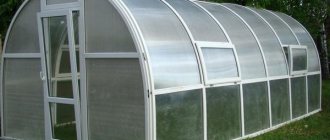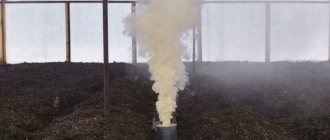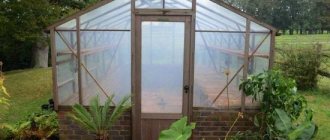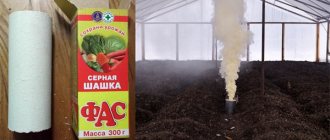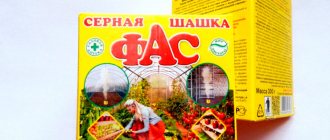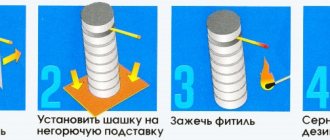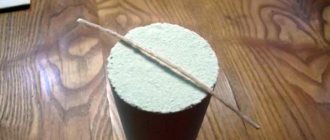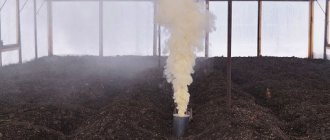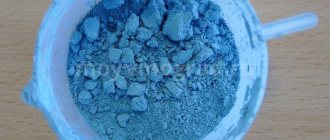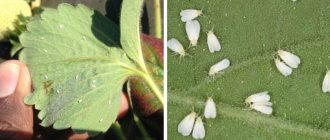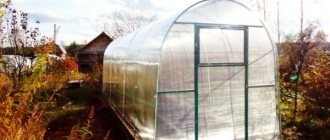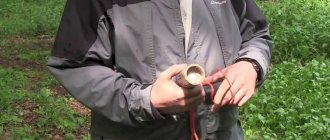Plants in closed ground are susceptible to many diseases and pest attacks. Annual disinfection of the greenhouse using a sulfur bomb will help to avoid this. This method of disinfection allows you to get rid of diseases and insects in one or two procedures.
The technology for fumigating greenhouses with smoke bombs is quite simple, but for it to be effective and safe, the instructions must be strictly followed.
Sulfur block for polycarbonate greenhouse
The principle of operation of a sulfur bomb
A sulfur block is a set of tablets containing the active substance – sulfur – in an amount of 750 g/kg. When smoldering, the checker releases sulfur dioxide, which effectively kills bacteria, viruses and fungi, as well as harmful insects. The checker has a depressing effect on rodents and scares them away.
The checker consists of 5-10 tablets and is designed to treat a certain volume of the room. For processing, take the required number of tablets, set them on fire with a wick and leave the checker to smolder in a tightly closed greenhouse. This produces a large volume of smoke that fills the structure.
Sulfur checker
Smoke easily penetrates into hard-to-reach places: joints of frame elements, polycarbonate, cracks in the foundation and fences of beds - where pests and pathogens accumulate. When combined with vapors and drops of moisture, the anhydride forms sulfurous acid, which gives an additional disinfecting effect and disinfects the soil and walls of the greenhouse.
A special wick comes complete with smoke bombs
Ways to control rodents Mousetraps and rat traps
If there are few mice, use mousetraps (cost 50–200 rubles). For bait, place pieces of cheese, lard, sausage, bread dipped in vegetable oil.
Mousetraps have a base made of plastic or wood, a spring, a bracket, and a place for bait. In 1894, American William Hooker received a patent for the invention of a mousetrap.
Use traps to catch rats.
Rat traps consist of a spring, serrated bars or plates that trap the animal, and a platform that operates the mechanism. Some rat traps include fragrant bait and cost 600–700 rubles
Tie traps and mousetraps to water pipes and heavy furniture. A wounded animal may escape with the trap. Rodents often survive in traps and mousetraps; you have to kill them yourself.
Electric rat traps (cost 2,500–5,000 rubles) operate from an outlet or batteries. Advantage: rodents die instantly, no need to touch the corpses. Dump the trap reservoir into a trash container.
Rodents fall into a chamber of electrical traps and die in the chamber from a current discharge of 8000–1200 V
When to treat a greenhouse with a sulfur bomb
Disinfection of the greenhouse using a checker is carried out in the fall, after the end of the growing season and complete cleaning of the greenhouse, and also in the spring, no later than two weeks before planting the first crops. Fall treatment is usually carried out in September or early October. In spring, you can begin disinfection in April.
Treatment of a greenhouse with a sulfur bomb
The temperature during fumigation must be at least +10°C. If the greenhouse is located in an area with high groundwater, treatment must be postponed until the soil dries to a depth of at least 10 cm. Otherwise, sulfurous acid will penetrate into the deep layers of the soil, which will adversely affect the activity of soil bacteria.
How to understand that there are mice in the room
As a rule, the first characteristic sign is the presence of an unpleasant odor. It is especially acute in unventilated buildings where there have been no people for a long time. The most dangerous manifestation is the detection of marks from teeth and excrement located in or near products. If mice are not afraid to leave their holes in the presence of people, it means that they feel free and at ease, and the population size is quite large. Why do mice appear indoors? This occurs under favorable conditions:
- Easy access to food
- Presence of dark, warm places that are difficult to reach for people and pets
- Location of outbuildings, abandoned buildings, destroyed communications near the house.
If at least one or more conditions from this list exist, the likelihood of rodents appearing in the house and garden increases significantly.
The benefits and harms of sulfur bombs
Before you start treating a greenhouse with a sulfur bomb, it is necessary to evaluate its benefits and harm to the structure itself, the soil and the plants.
Advantages of sulfur bomb:
- effective against fungus and mold, bacteria and harmful insects;
- has high penetrating ability;
- economical;
- easy to use.
But there are also disadvantages that should also be kept in mind.
- The toxicity of sulfur bombs is extremely high, so its use requires compliance with safety rules.
Sulfur smoke bombs are very toxic
- Sulfur dioxide has a destructive effect on unprotected metal frame parts.
- After repeated treatments, polycarbonate becomes cloudy and becomes covered with microcracks.
- The acid formed as a result of the reaction of smoke with water kills not only harmful, but also beneficial microorganisms, worsening soil fertility.
- The effect of the sulfur bomb does not extend to deep layers of soil.
- Treatment cannot be carried out during the growing season and less than two weeks before planting.
Important! When using a sulfur bomb, you must strictly follow safety precautions: the bomb is a fire hazard, and its smoke is poisonous!
When treating a greenhouse with a sulfur bomb, it is important to follow safety precautions
Considering all the disadvantages and difficulties in using sulfur bombs, before using it it is necessary to evaluate the feasibility of processing. Experienced gardeners advise using a sulfur bomb in the following cases.
- Plants of the same species were grown in a greenhouse for several years in a row, having common pests and diseases.
- During the season, outbreaks of fungal and bacterial diseases with a large area of damage were observed in the greenhouse or in its immediate vicinity.
- Insect pests were noticed on the plants, and the fight against them using folk remedies or systemic insecticides turned out to be ineffective.
- The plants in the greenhouse are infected with spider mites - they are difficult to remove using conventional means.
In other cases, it is better to carry out preventive disinfection of greenhouses using biological products - they do not have a harmful effect on the soil and the structure of the greenhouse. You can also use other types of checkers with fungicidal and insecticidal effects.
Prices for sulfur bombs
sulfur bombs
Gas protection
You can protect yourself from toxic sulfur anhydride using a gas mask. A respirator and safety glasses can be used, but only if the treatment area is small and a maximum of two tablets is used.
As a rule, two people carry out the processing. One controls the process, and the other processes the room. If the floor in the greenhouse is wooden, you cannot place a saber with a wick on it. A basin or other objects are usually used for this.
You cannot be distracted by food or drink liquids during the process. There should be no children or animals nearby. Immediately after setting fire, a person must leave the room; being among the smoke is extremely dangerous. If several checkers are set on fire, they should be lit in such order that the handler moves towards the exit and has time to get out before the smoke starts to flow.
Types of smoke bombs
Which sulfur bomb should I choose for processing a polycarbonate greenhouse? This question worries many novice summer residents. Often, sulfur bombs are mistakenly classified as means for killing insects and microorganisms based on other toxic substances. The scope of application of the smoke bomb and its effectiveness depend on the active substance.
Table 1. Types of smoke bombs.
| Type of smoke bomb | Description |
| Checkers FAS, Climate, Pawn | Sulfur-based checkers are used to get rid of fungal and bacterial infections, mold, and rot. They are also effective against insect pests: spider mites, aphids, thrips, whiteflies, leaf-eating caterpillars, slugs. It inhibits plants; treatment is carried out only in an empty greenhouse after complete harvesting of the crop and plants. |
| Checkers G-17, G-20 | Smoke bombs based on hexachlorane, a systemic insecticide with contact-intestinal action. Effective against aphids, caterpillars, thrips and whiteflies. They have no noticeable effect on herbivorous mites. They are also useless against diseases. Use during the growing season is not allowed. |
| Checker Whist | Checkers with didecyl-dimethyl-ammonium bromide have a pronounced fungicidal and bactericidal effect, and also kill insect pests. Checkers with bromide effectively fight wet rot and fungal infections. It is allowed to use the checker in the first weeks of the plant growing season, even before the start of fruiting. |
| Checkers City, Quiet Evening, Tsifum | Checkers based on permethrin have a wide range of effects on insect pests. Effective against all types of aphids, caterpillars, mites, thrips, whiteflies, as well as their larvae. Checkers with permethrin are fireproof, their surface does not heat up when fumigated. They do not inhibit plants and can be used during the growing season before fruiting begins. |
| Checkers Vulcan, Hephaestus | Tobacco sticks, the active ingredient is nicotine. Used in greenhouses during any growing season and after harvesting to combat harmful insects: aphids, whiteflies, spider mites, thrips, most butterflies and caterpillars. Smoke has practically no effect on the larvae, so twice treatment is required with an interval of 10-15 days. Tobacco sticks are useless against rot and infections. |
A type of insect checker
As can be seen from the table, sulfur bombs have the widest spectrum of action, so they are most often chosen for complete disinfection of greenhouses after the end of the season. In order not to harm the soil, greenhouse frame and polycarbonate, it is necessary to follow the processing technology.
Five proven methods for killing mice in the garage
Rodents in a garage can destroy wiring in a car and thoroughly damage expensive upholstery in one day. Not everyone wants to keep a cat in the garage - the main reason is unpleasant odors that cannot be avoided. How can you get mice and rats out of your garage?
The first method is traditional mousetraps.
Mechanical destruction and disposal of captured rodents is not a pleasant task. Mousetraps should be installed near the holes, “loaded” with treats for mice, and then the killed rodents should be taken out and thrown away.
It is not necessary to install traditional mousetraps with a spring mechanism - there are simpler methods for catching rodents:
- three-liter glass jar - bait (lard, cheese, sausage) is placed inside the jar. Now we need to create a bridge over the can so that the mouse can climb into it. To do this, place the jar under a low stool, on which we place a board. The mouse gets into the jar along the board, but can no longer get out of it. All that remains is to take out and destroy the rodent,
- glue trap - the idea is that a bait is placed in the center, and the mice simply stick to the cardboard. The unpleasant thing is that you have to throw them away regularly,
- with rats it is more difficult, you need a special powerful rat trap, rats are easily released from the mousetrap.
You can catch one or two mice using this method. But, if mice or rats have taken up residence in the garage or regularly come from neighbors, then more radical methods are needed.
The most effective mouse trap baits:
- The best bait is grain and any cereals. In nature, mice do not often see cheese, but eat food that is familiar to them. The ideal solution is fragrant bread with the addition of bran and nuts,
- sunflower oil (unrefined), moisten grain or plain bread,
- Rodents love sesame oil - this is the best bait.
DIY glue trap:
- pour glue into a small tray (a special one is sold in the store), it does not dry out for a long time,
- We place bait in the center - a piece of bread,
- We place a homemade glue mousetrap in a secluded place in the garage.
Now all that remains is to remove the mice from the adhesive base and throw them away.
https://youtube.com/watch?v=AtlvqqZgM88%3Ffeature%3Doembed
The second method is pesticides
The poison is placed near mouse holes, mixed with bait (boiled egg, minced meat). There is one big drawback to this method - a poisoned mouse can die under the finishing. The result is an unpleasant smell in the garage.
Therefore, you need to choose pesticides that act on the respiratory system of rodents. In this case, they crawl out of their holes and dead individuals can be easily thrown away.
The third method is sulfur bomb
How to get mice out of the garage quickly? A sulfur bomb will help, but in order for the treatment to be effective, you need to carefully close all ventilation pipes and ensure that the room is completely sealed.
Within two days there will be no rodents in a room treated with a sulfur smoke bomb. There is also a minus - the smell of sulfur eats into wooden and fabric surfaces for a long time.
Another disadvantage is that sulfur, when it enters into a chemical combination with metal, can cause rapid corrosion when humidity increases.
The fourth method is rodent repellers
For a small garage, this method is effective, since the rodents do not like the low frequency sound, and they leave. It must be taken into account that low-power devices, they are usually inexpensive, household ones, do not pass through partitions, even wooden ones.
Therefore, you need to choose professional repellers for the garage; they cost about 5,000 rubles, no less.
The fifth method is the most effective, deratization
Calling specialists will cost approximately 2,000 rubles, depending on the region. A comprehensive garage treatment is guaranteed to keep mice away for at least six months. You won’t have to deal with unpleasant procedures for catching and destroying rodents.
This is the best solution on how to get rid of mice and rats in the garage forever.
Important. Mice and rats enter the garage through voids and holes in the walls and ceiling
If you carefully fill all the gaps and install protective nets on the ventilation pipes, then rodents simply will not enter the room.
https://youtube.com/watch?v=i4_iHP4pEY8%3Ffeature%3Doembed
Greenhouse processing technology
The process of fumigating a greenhouse with a sulfur bomb does not take much time - the bomb burns for several hours. However, the effect of sulfur dioxide continues for two to three days. To increase the effectiveness of the product, it is recommended to choose the correct dosage and follow the step-by-step processing instructions.
Calculation of sulfur bomb dosage
The checker consists of several tablets, which allows you to most accurately select the dose of the active substance. The calculation is based on the volume of the greenhouse, the consumption of the active substance is indicated on the packaging.
Action of sulfur bomb
Below is an example calculation.
- For processing the greenhouse, a “Climate” checker weighing 300 grams, 10 tablets was selected. The size of the greenhouse is 3x6x2.2 meters.
- Calculating the volume of a greenhouse is quite simple: you need to multiply its geometric dimensions in meters, the result is the volume in cubic meters. For the given dimensions of the greenhouse it will be 3·6·2.2=39.6 m3.
- According to the manufacturer’s recommendations, one block weighing 300 g is enough to process 20 m3 of a greenhouse.
- To process the greenhouse you will need 39.6:20=1.98, that is, 2 checkers of 300 g or 20 tablets.
The estimated number of checkers is distributed into several groups so that fumigation is carried out evenly. It should be noted that the wick smoldering time is 90 seconds, after which poisonous gas is released. The number of checkers must be calculated so that you have time to set them on fire and leave the greenhouse in a minute and a half.
Important! If the greenhouse volume is large and several bombs are used at the same time, it is recommended to use a gas mask and a protective suit to avoid poisoning.
How to use a sulfur bomb in a greenhouse
Not only the effectiveness of processing, but also your safety depends on the correct use of the checker. Therefore, it is recommended to strictly follow the instructions given in Table 2.
Instructions for use of FAS sulfur smoke bomb
Table 2. Step-by-step instructions for using sulfur bombs in a greenhouse.
| Steps, illustrations | Description of actions |
| Cleaning of cultivated plants and weeds | Treatment of the greenhouse with a sulfur bomb is carried out only after complete removal of vegetation from the greenhouse. Cultivated plants are removed, tops and residues are burned. It is not recommended to use them for compost. Weeds are pulled out, paying special attention to plants with powerful taproots. Pest larvae often hide in their root rosettes for the winter. If signs of disease or pests are detected, the weeds are burned or taken outside the garden. Healthy plants can be placed in a compost heap. |
| General cleaning in the greenhouse | The walls of the greenhouse are washed with warm water and liquid detergent. For washing I use a soft sponge or rag; the use of brushes and scrapers for polycarbonate is not recommended - you can damage its surface, after which it becomes cloudy. When washing, pay special attention to the joints of the polycarbonate and the frame. Dust and dirt usually accumulate there, where bacteria, fungal spores and mites overwinter. They can be further cleaned with a soft brush. Finally, the walls of the greenhouse are washed with water from a hose. |
| Tillage | Smoke from a sulfur bomb can penetrate only into loose soil to a depth of no more than 5 cm. Most pests lay their larvae at greater depths for the winter. Therefore, to increase the efficiency of processing, it is recommended to dig up the soil in the greenhouse and loosen it. In this case, the larvae and pests will appear on the surface and will be destroyed. The top layer of soil can be removed and taken outside the greenhouse. |
| Greenhouse sealing | Using a sulfur bomb is only possible in a sealed room, otherwise the smoke will escape and the bomb will be ineffective. In addition, the smoke is poisonous, and if it comes out you can get poisoned. The greenhouse is sealed by sealing cracks and joints with sealant, tape or putty. To enter the greenhouse, one of the doors is left, and it can be sealed using a rubber window seal, and after igniting the checkers, it can be additionally sealed with tape. |
| Protection of metal structures | When exposed to sulfur dioxide on unprotected metal, a corrosion center is formed. Therefore, checker manufacturers recommend coating unpainted metal parts with grease or other thick organic-based lubricant before starting processing. If paint chips are observed on the frame of the greenhouse, it is recommended to first restore the coating and dry it. Particular attention should be paid to parts that experience mechanical stress: door hinges, door frames and vents - these are where the paint comes off most often. |
| Ensuring personal safety | The smoke from the bomb is poisonous and can cause irritation if it comes into contact with wet skin. Therefore, before starting processing, it is necessary to put on protective clothing - a special suit or overalls made of thick fabric with long sleeves. Gloves are put on your hands and your head is protected with a hood or scarf. The respiratory organs are protected with a respirator. If possible, use a gas mask. |
| Wetting surfaces | To increase efficiency, immediately before treatment, moisten the walls of the greenhouse and the top layer of soil with a hose or sprayer. High humidity promotes the conversion of sulfur dioxide into sulfurous acid, which is an antiseptic and preservative. When in contact with moisture, ash or some mineral fertilizers, sulfurous acid turns into sulfuric acid, the effect of which on the soil is extremely negative, so you cannot fertilize the soil in the greenhouse before treating it with a saber! |
| Preparing the base for the checker | The sulfur bomb heats up when smoldering; to use it, it is necessary to prepare a non-combustible base. This could be paving slabs, a sheet of metal, an enamel basin or bucket. If there are concrete or tiled paths in the greenhouse, you can place the saber directly on them, provided that there are no flammable objects nearby. |
| Lighting a checker | The checker is placed strictly vertically on the base, and the wick that comes with the checker is inserted under the top tablet. In its absence, the saber is ignited using a newspaper. After making sure that the wick is burning steadily, you need to quickly leave the greenhouse and close the door behind you. If there are cracks in the door, they are immediately sealed with tape or sealed in some other way. |
| Fumigation and disinfection of the greenhouse | The emission of smoke continues for several hours. It completely fills the greenhouse, settles on the walls, soil and in hard-to-reach places. The effect of anhydride on bacteria and pests continues for 24-72 hours, so it is better not to open the greenhouse for the next three days. |
| Ventilation and subsequent cleaning | After holding for three days in the greenhouse, open the doors and vents and ventilate it until the specific odor completely disappears. To avoid clouding of the polycarbonate and corrosion of the frame, it is recommended to rinse the greenhouse with a small amount of clean water. |
| Subsequent soil treatment with EM preparations | Sulfur has a negative effect on soil microorganisms and kills beneficial fungi and bacteria. To restore soil fertility, it is recommended to add a solution of biological products, such as Emochka, Baikal EM1, Siyanie EM2, before the start of the new season. Treatment is carried out in the spring after the upper layers of the soil have been warmed to a temperature of +15°C. The solution temperature should be within 25±5 °C. The soil is watered from a watering can and left for 5-7 days, after which the plants begin to be planted. |
How to set fire to a sulfur bomb in a greenhouse
Disinfection of a polycarbonate greenhouse in the fall
Treatment must begin with the removal of all plant residues, weeds, mulch - various pests can hide and overwinter in them. Tops affected by diseases and pests are burned. Read more here.
Rules of application
There are certain rules that must be followed. Otherwise, it will simply be impossible to achieve the maximum effect:
- If you need to poison mice, rats and moles, you need to throw a saber directly into the pest's hole.
- You can use a checker even if livestock lives inside the room. But at the same time, the animals must first be removed from their camps, and then everything must be properly ventilated.
- Once the room has been treated, under no circumstances should you go inside for several hours.
- If, after the room has been completely ventilated, a slight burning smell still remains for several days, then in this case it is necessary to ventilate the area more thoroughly.
- If it is necessary to treat the greenhouse, the entire procedure should be carried out several weeks before sowing. This is explained by the fact that toxic substances can damage cultivated plants if the greenhouse is not ventilated in time.
- Under no circumstances should such means be used in city apartments, as this would be a violation of the current legislation of the Russian Federation. Violation of the rules will result in criminal liability.
- Under no circumstances should you mix a purchased saber with various chemicals, as the effect will be unpredictable.
Before use, be sure to study the instructions and operating rules. If you neglect these conditions, then you can seriously poison yourself or crops or livestock.
Step-by-step instruction
Checkers cannot be used randomly. You must adhere to certain actions:
- To begin with, you should make sure that all the cracks are well sealed and the windows are closed.
- The checker must be placed in the very center of the room that needs to be processed. The surface on which it will be placed must be absolutely non-flammable, since it can cause a fire.
- It is necessary to use a jar in which the checker will be placed. It needs to be filled with water. Typically, all models have marks that will indicate to what level the space needs to be filled.
- The jar itself will also need to be immersed in a container of water.
- There are several types of such products, so you need to read the instructions. Some checkers go off when they come into contact with water, while others need to be set on fire.
- After setting fire, the room must be left immediately. When 3 hours have passed, the doors must be opened.
It is worth noting that you can only go inside if you have a respirator and rubber gloves. Wearing protective equipment requires wet cleaning.
Preparing for action
Before lighting a checker, you must ensure that the necessary preparation has been made for all manipulations with the equipment:
- All holes must be sealed very well. For these purposes, you can use felt material or dampened rags.
- All objects made of metal must be removed from the premises. Otherwise, corrosion may occur.
- If metal objects cannot be removed, they must be treated with an oil solution or purchased a special antiseptic. All edible products must also be removed from the premises.
After all these steps, you can start using the checker. It is worth noting that under no circumstances should these rules be ignored.
Symptoms of poisoning
When poisoned, a person experiences dizziness and severe headache. begins to choke and hoarseness appears . Depending on the degree of poisoning, your nose may bleed and your eyes may become sore.
A person poisoned by sulfur smoke is taken out into the fresh air. You should definitely seek help from a toxicologist . Sulfur tablets should not be stored near food or medicine.
You should not ignore the instructions, which say how many tablets are required for a certain area of territory. When using more checkers than required, not only harmful bacteria and fungi can die, but also those microorganisms that are necessary for future plants. Once the soil is damaged, it will be difficult to restore it later.
In order for the sulfur bomb to bring maximum effect, carry out preliminary preparation as thoroughly as possible . Remains of plants and debris should be removed from the premises, metal structures should be treated with grease and the walls should be wiped with soapy water. All this is done to prevent harmful microorganisms from surviving.
